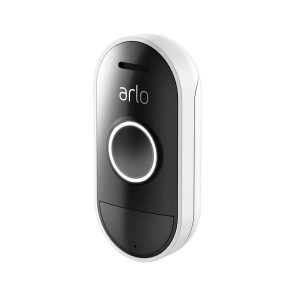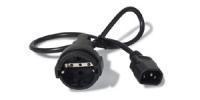Description
Power Cable, No, Device Cable, IEC C19, Black
APC AP8758 3m properties
| Product name |
AP8758 3m |
| Type |
Power Cable |
| Grounded |
No |
| Cable Length |
3.05 m |
| Connector |
IEC C19 |
| Area of Use (Cable) |
Device Cable |
| Maximum Power (without spikes) |
16.0 A |
| Colour |
Black |
| Depth |
10.2 cm |
| Weight |
490.0 g |
Frequently Asked Questions:
How do I properly install and configure the APC AP8758 UPS to ensure reliable power protection for my sensitive equipment during power outages or surges?
Unpacking and Inspecting:
a. First, unpack the APC AP8758 UPS from its packaging and inspect it carefully for any visible damages. Ensure that all the required components are included in the package. Preparing the Site:
a. Choose a location with easy access to power outlets and enough ventilation. Ensure that the floor is level and stable enough to support the weight of the UPS. Connecting the AC Input:
a. Plug the AC input power cord into a grounded wall socket and connect it to the AP8758 UPS's "AC In" port. Configuring the Battery Backup Output:
a. Attach the battery backup output cable to the "OUT1" port on the back of the UPS. Connect your sensitive equipment, such as computers or servers, to this output using power cords. Setting Up the USB Port:
a. Insert the included USB cable into the AP8758 UPS's "USB Out" port and connect it to your computer. Follow the on-screen instructions to install the provided software, which will allow you to monitor the UPS status and perform various configurations. Checking the Settings:
a. Press the "Menu" button on the front of the AP8758 UPS to access its settings menu. Use the arrow keys to navigate through the options, such as setting the UPS's voltage level or configuring the beeper alarm. Save your changes by pressing the "Enter" key and then exit the menu. Testing the UPS:
a. Press and hold the "Test" button on the front of the AP8758 UPS until the LCD screen displays "TEST". Release the button, and the UPS will simulate an outage and switch to battery backup mode for 10 seconds before restoring power from the AC input. Monitoring the UPS:
a. Use the USB software to monitor the UPS's status, such as the battery level or load percentage. Maintenance:
a. Regularly check and clean the UPS's air vents and fans to ensure proper ventilation and prevent overheating. Troubleshooting:
a. If you encounter any issues, such as low battery level or voltage fluctuations, consult the user manual for troubleshooting tips or contact APC's customer support.
How do I properly install and configure an APC AP8758 3m for backup power in my office setup?
Before starting with the installation, ensure that you have all the necessary components, such as the UPS unit, surge protectors, battery packs, and power cords. Check the compatibility of your devices with the AP8758 UPS. Choose a suitable location for the UPS. It should be placed on a level surface, away from moisture, heat sources, and direct sunlight. The area around it must have good ventilation to prevent overheating. Connect the power cord of the UPS to an electrical outlet that is not shared with any other devices. Make sure the cord is securely plugged in. Attach the surge protectors to the UPS using the provided cords. Ensure that each connector is properly seated in the appropriate slot on the UPS. Insert the battery packs into their respective slots, aligning them with the notches on the UPS. Push them firmly until you hear a click to ensure proper connection. Connect your office equipment, such as computers, servers, and peripherals, to the surge protectors using the appropriate cords. Make sure that each device is connected securely to the correct outlet. Turn on your devices one by one to test their compatibility with the UPS. Ensure that they are recognized by the operating system and that they can function properly. Configure the UPS settings using the LCD display or an attached computer. This will involve setting up the backup time, load management preferences, and other parameters based on your specific requirements. Test the UPS performance by simulating a power outage or using a load test device to check its capacity. Ensure that it can provide adequate backup power for the required duration. Regularly maintain the UPS unit by cleaning it regularly, checking for any issues with the battery packs, and performing firmware updates as necessary. This will help ensure its long-term reliability and functionality.
The circuit breaker trips when I close it, but not when I open it. What's causing this issue with my APC AP8758 3m?
1. Faulty Circuit Breaker**: The most obvious cause is a faulty circuit breaker. If the breaker is not functioning correctly, it can trip when closed but not when open. Check if the breaker is properly seated and that there are no signs of physical damage. Loose Connections**: Over time, connections in the wiring or within the APC device itself can become loose. This can cause the circuit to malfunction, leading to the breaker tripping. Inspect all connections carefully for any sign of wear or damage. Ground Fault Current**: Ground fault current is another common issue that can cause a circuit breaker to trip. If there's an electrical path to ground, it can cause the breaker to trip when closed but not when open. This is because when you close the breaker, it completes the circuit and allows the current to flow to ground, tripping the breaker. Faulty APC Device**: It's also possible that the issue lies within the APC device itself. Sometimes, these devices can malfunction due to a variety of reasons such as power surges or internal component failures. Overload Protection**: Some circuit breakers have overload protection built in. If the load connected to the breaker exceeds its capacity, it can trip even when opened. Check your circuit breaker's specifications and ensure that you're not exceeding the maximum allowed current. To diagnose the issue further, I recommend checking the circuit breaker for any signs of physical damage or wear. Also, try using a multimeter to check if there are any voltage drops in the wiring. If you find any issues, it might be worth consulting an electrician for professional assistance.










Reviews
There are no reviews yet.